Scientists discover genes involved in immunity of sea fans to coral diseases.-

In sea fans, scientists discover new immunity genes. See photo gallery for sea fan 'Message in a Bottle.'
Credit: NSF
Credit and Larger Version
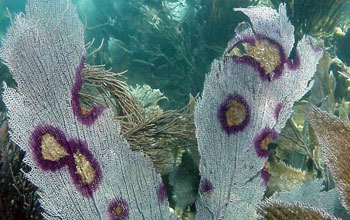
| A sea fan fights back against disease; its response is marked by dark purple inflammation. Credit: E. Weil |
| Download the high-resolution JPG version of the image. (804 KB) |
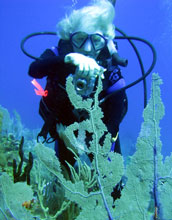
| Scientist Drew Harvell examines sea fans in Puerto Rico for signs of recovery. Credit: E. Weil |
| Download the high-resolution JPG version of the image. (668 KB) |
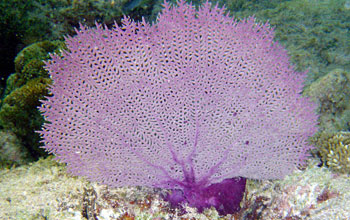
| Beautiful and healthy now, the purple sea fan may fall ill from a host of infectious diseases. Credit: Wikimedia Commons |
| Download the high-resolution JPG version of the image. (246 KB) |
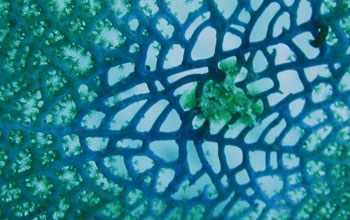
| Close-up of formerly sick sea fan that's recovering nicely from ocean diseases. Credit: D. Harvell |
| Download the high-resolution JPG version of the image. (129 KB) |
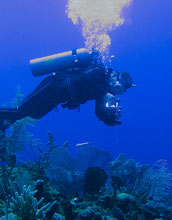
| Marine ecologist Ernesto Weil looks at a sick sea fan; he's studying sea fan immune systems. Credit: D. Harvell |
Download the high-resolution JPG version of the image. (506 KB)
|
The following is part five in a series on the NSF-NIH Ecology and Evolution of Infectious Diseases (EEID) Program. For part one, see Cool Cat in a Hot Zone. For part two:
For part three: Underwater Whodunit: What's Killing Florida's Elkhorn Coral?
For part four: "Defective" Virus Leads to Epidemic of Dengue Fever.
Like all of us, corals get sick. They respond to pathogens (disease-causing microbes) and recover or die. But unlike us, they can't call a doctor for treatment.
Instead, help has arrived in the form of scientists who study the causes of the corals' disease, and the immune factors that might be important in their response and resistance.
With support from the National Science Foundation (NSF), scientists Drew Harvell and Colleen Burge of Cornell University and their colleagues have developed a catalog of genes that, the researchers say, will allow us to better understand the immune systems of corals called sea fans.
The marine ecologists have trained their undersea eyes on a particular sea fan species, Gorgonia ventalina, or the purple sea fan, found in the western Atlantic Ocean and the Caribbean Sea.
The team has monitored sea fan health in the Florida Keys, Mexican Yucatan and Puerto Rico for the past 15 years. The most recent research, in collaboration with Ernesto Weil of the University of Puerto Rico, is underway on reefs at La Parguera, Puerto Rico.
Gorgonia ventalina is a fan-shaped coral with several main branches and a latticework of smaller branches. Its skeleton is composed of calcite and gorgonian, a collagen-like compound. Purple sea fans often have smaller, accessory fans growing sideways out of their main fans.
These large sea fans fare best near shore in shallow waters with strong waves and on deeper outer reefs with strong currents, down to a depth of about 50 feet. Small polyps on the graceful fans catch plankton drifting by on fast-flowing currents.
Turning (more) purple
Life as a purple sea fan isn't always easy. The coral may be attacked by the fungus Aspergillus sydowii, which causes the disease aspergillosis.
It results in damaged patches on the fan, extreme purpling of tissues and sometimes death. Several outbreaks of aspergillosis have occurred in the Caribbean; corals in stressful conditions such as warming waters may be especially susceptible.
"Diseases and climate change are very tightly linked," says Mike Lesser, program director in NSF's Division of Ocean Sciences, which funds the research along with the joint NSF-National Institutes of Health Evolution and Ecology of Infectious Diseases (EEID) Program.
"The role of climate change in diseases is important," Lesser says, "for understanding the spread of infectious diseases in every corner of the globe, including the oceans."
Adds Sam Scheiner, NSF EEID program director, "Human-induced climate change is having profound effects on many parts of the world. As this research shows, coral reefs are being decimated by the combination of climate change and infectious diseases."
Undersea "doctors" come to sea fans' aid
Harvell agrees.
In a paper published earlier this year in The Annual Review of Marine Science, Harvell, Burge and other scientists reviewed climate change influences on marine infectious diseases.
Now the scientists are using the purple sea fan as a model for studying ocean diseases. "We're looking at microbial infection, pathways of defense and the health of this sea fan in the face of warming waters and climate change," says Harvell.
"All animals on Earth--from humans to fish to corals--are susceptible to infection by pathogens that cause illness," she says. "What we hope to answer is: How widespread are these infections? Why do they happen? And, what can we do about them?"
Coral reefs are declining worldwide. Even very old coral colonies in remote locations are dying. "Disease-related deaths are caused in part by pathogens alone and in part by interactions between pathogens and climate change," says Burge.
Many of these pathogens are unidentified, leaving sea fans and their coral relatives at high risk.
But the mystery is slowly being solved.
The scientists have discovered two pathogens in purple sea fans. The microbes are being cultured and used to examine how sea fans' immune systems work.
Past is prologue?
A look back a decade or more may provide clues to the present--and the future--for sea fans.
From 1996 through 2004, thousands of sea fans in the Caribbean died of aspergillosis. Many survived, however, and appear resistant to further attack.
But they're far from home free.
Purple sea fans are now being infected by a new pathogen, called Aplanochytrium. Burge was the first to isolate and culture the microbe from a sick sea fan.
Aplanochytrium is a member of an order of lethal microbes known as Labyrinthulomycetes. It grows faster at warmer temperatures, leaving sea fans in "hot water."
Corals don't have "immune memory," such as the T cells and antibodies found in humans. Instead they have an ancient defense system called the innate immune system.
Studying sea fans' immunity through their genes is an important step in protecting them, says Burge.
"We used molecular biology and bioinformatics--a combination of biology, computer science and information technology--to make a set of the genes' messages, called transcripts," she says. "Then we characterized these messages, which are known collectively as a transcriptome."
The results, reported this month in a paper in the journal Frontiers in Physiology, are the first to show which genes are activated in response to pathogens in sea fans. Co-authors of the paper are Burge, Harvell and Morgan Mouchka of Cornell, and Steven Roberts of the University of Washington.
Message in a (genetic) bottle
The purple sea fan may hold messages for the oceans, and for us, but the messages come in a genetic bottle.
The scientists studied what's called messenger RNA, which transfers genetic messages, in sea fans exposed to Aplanochytrium, comparing it with that of unexposed sea fans.
They found that the sea fans' genes hold clues to questions such as how the fans recognize and kill pathogens, and how they repair injured tissues.
The scientists are increasing the sea fan genetic "catalog" by adding genes expressed, or turned on, in response to record-breaking Caribbean Sea temperatures in 2010.
The researchers, working in Puerto Rico with Weil and Laura Mydlarz of the University of Texas at Arlington, assessed the effect of the 2010 Caribbean coral bleaching event, as it's known, on sea fans' genes and immune function.
The study compared immune system genes in a heat-sensitive coral species, Orbicella annularis, the boulder star coral, with that of Gorgonia ventalina.
The purple sea fan was thought to be resilient to the stresses of warming waters. But Gorgonia ventalina, the scientists found, is also susceptible to the double whammy of disease and warming.
| -- | Cheryl Dybas, NSF (703) 292-7734 cdybas@nsf.gov |
Related WebsitesNSF Special Report: The Ecology and Evolution of Infectious Diseases:
http://www.nsf.gov/news/special_reports/ecoinf/index.jsp
NSF Award: EEID: Evaluating the Effects of a Changing Ocean on Management and Ecology of Infectious Marine Disease:
NSF Award: EEID: Evaluating the Effects of a Changing Ocean on Management and Ecology of Infectious Marine Disease:
http://www.nsf.gov/awardsearch/showAward?AWD_ID=1215977
NSF Award: Effect of the 2010 Caribbean Coral Bleaching Event:
NSF Award: Effect of the 2010 Caribbean Coral Bleaching Event:
http://www.nsf.gov/awardsearch/showAward?AWD_ID=1105201&HistoricalAwards=false
NSF News: Controlling the Spread of Diseases Among Humans, Other Animals and the Environment:
NSF News: Controlling the Spread of Diseases Among Humans, Other Animals and the Environment:
Guillermo Gonzalo Sánchez Achutegui

No hay comentarios:
Publicar un comentario